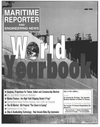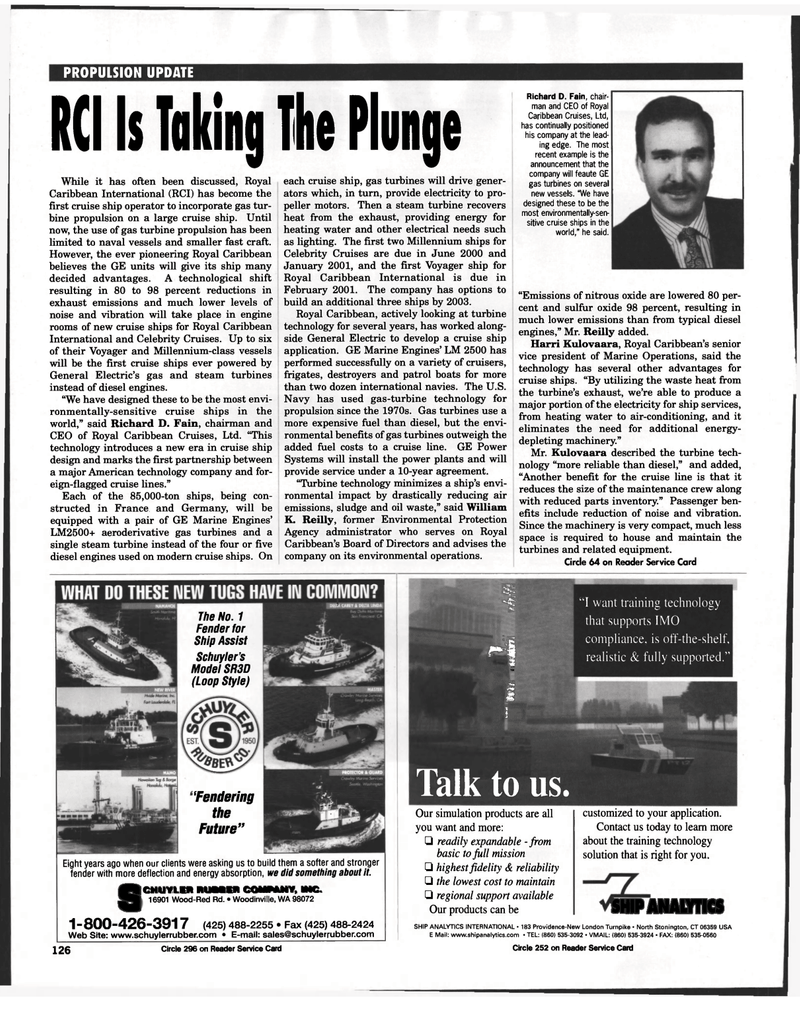
Page 124: of Maritime Reporter Magazine (June 1998)
Read this page in Pdf, Flash or Html5 edition of June 1998 Maritime Reporter Magazine
PROPULSION UPDATE
RCI Is Taking The Plunge
While it has often been discussed, Royal
Caribbean International (RCI) has become the first cruise ship operator to incorporate gas tur- bine propulsion on a large cruise ship. Until now, the use of gas turbine propulsion has been limited to naval vessels and smaller fast craft.
However, the ever pioneering Royal Caribbean believes the GE units will give its ship many decided advantages. A technological shift resulting in 80 to 98 percent reductions in exhaust emissions and much lower levels of noise and vibration will take place in engine rooms of new cruise ships for Royal Caribbean
International and Celebrity Cruises. Up to six of their Voyager and Millennium-class vessels will be the first cruise ships ever powered by
General Electric's gas and steam turbines instead of diesel engines. "We have designed these to be the most envi- ronmentally-sensitive cruise ships in the world," said Richard D. Fain, chairman and
CEO of Royal Caribbean Cruises, Ltd. "This technology introduces a new era in cruise ship design and marks the first partnership between a major American technology company and for- eign-flagged cruise lines."
Each of the 85,000-ton ships, being con- structed in France and Germany, will be equipped with a pair of GE Marine Engines'
LM2500+ aeroderivative gas turbines and a single steam turbine instead of the four or five diesel engines used on modern cruise ships. On each cruise ship, gas turbines will drive gener- ators which, in turn, provide electricity to pro- peller motors. Then a steam turbine recovers heat from the exhaust, providing energy for heating water and other electrical needs such as lighting. The first two Millennium ships for
Celebrity Cruises are due in June 2000 and
January 2001, and the first Voyager ship for
Royal Caribbean International is due in
February 2001. The company has options to build an additional three ships by 2003.
Royal Caribbean, actively looking at turbine technology for several years, has worked along- side General Electric to develop a cruise ship application. GE Marine Engines' LM 2500 has performed successfully on a variety of cruisers, frigates, destroyers and patrol boats for more than two dozen international navies. The U.S.
Navy has used gas-turbine technology for propulsion since the 1970s. Gas turbines use a more expensive fuel than diesel, but the envi- ronmental benefits of gas turbines outweigh the added fuel costs to a cruise line. GE Power
Systems will install the power plants and will provide service under a 10-year agreement. "Turbine technology minimizes a ship's envi- ronmental impact by drastically reducing air emissions, sludge and oil waste," said William
K. Reilly, former Environmental Protection
Agency administrator who serves on Royal
Caribbean's Board of Directors and advises the company on its environmental operations.
Richard D. Fain, chair- man and CEO of Royal
Caribbean Cruises, Ltd, has continually positioned his company at the lead- ing edge. The most recent example is the announcement that the company will feaute GE gas turbines on several new vessels. "We have designed these to be the most environmentally-sen- sitive cruise ships in the world," he said. "Emissions of nitrous oxide are lowered 80 per- cent and sulfur oxide 98 percent, resulting in much lower emissions than from typical diesel engines," Mr. Reilly added.
Harri Kulovaara, Royal Caribbean's senior vice president of Marine Operations, said the technology has several other advantages for cruise ships. "By utilizing the waste heat from the turbine's exhaust, we're able to produce a major portion of the electricity for ship services, from heating water to air-conditioning, and it eliminates the need for additional energy- depleting machinery."
Mr. Kulovaara described the turbine tech- nology "more reliable than diesel," and added, "Another benefit for the cruise line is that it reduces the size of the maintenance crew along with reduced parts inventory." Passenger ben- efits include reduction of noise and vibration.
Since the machinery is very compact, much less space is required to house and maintain the turbines and related equipment.
Circle 64 on Reader Service Card
Eight years ago when our clients were asking us to build them a softer and stronger fender with more deflection and energy absorption, we did something about it. s
CHUYLER RUBBER COMPANY, INC. 16901 Wood-Red Rd. • Woodinville, WA 98072 1-800-426-3917 (425) 488-2255 • Fax (425) 488-2424
Web Site: www.schuylerrubber.com • E-mail: [email protected]
Jl ^ : m H §11
Jte, . '.ip' 1 "I want training technology that supports IMO compliance, is off-the-shelf, realistic & fully supported." i§ (p
It 9 I
Talk t 0 us.
Our simulation products are all you want and more: • readily expandable - from basic to full mission • highest fidelity & reliability • the lowest cost to maintain • regional support available
Our products can be customized to your application.
Contact us today to learn more about the training technology solution that is right for you.
SHIP ANALYTICS 126 Circle 296 on Reader Service Card
SHIP ANALYTICS INTERNATIONAL • 183 Providence-New London Turnpike • North Stonington, CT 06359 USA
E Mail: www.shipanalytics.com • TEL: (860) 535-3092 • VMAIL: (860) 535-3924 • FAX: (860) 535-0560
Circle 252 on Reader Service Card
The No. 1
Fender for
Ship Assist
Schuyler's
Model SR3D (Loop Style)
Tendering the
Future"

 123
123

 125
125
